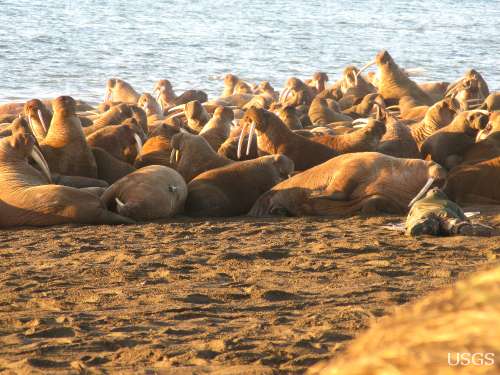Habitat
![Used with permission. accessed [20/02/2014], © Hinterland Who's Who (www.hww.ca). Used with permission.](Website/clip_image002.jpg)
Walruses are found in icy habitats, which includes the
Artic and Subartic regions where ice is more prevalent, around
the Northern Hemisphere (U.S. Fish and Wildlife Service.
1995.). There are two different species of walrus: Atlantic
walrus and the Pacific walrus. The Atlantic walrus that
lives near Northeastern Canada and Greenland and the Pacific
walrus, can be seen around the Bering, Laptev, and Chukchi Seas
(Goswami, A. and K.E. Jones. 2010; National Geographic Society.
1996.). Walruses live together in herds, but only at
certain times; males and females will live in separate herds
when it is no longer mating season (Defenders of Wildlife.
2013.).
An important factor as to where a walrus will inhabit is the water
depth. Water depth is important because this dictates how far a
walrus will have to go do to be able to get food. Thus walruses
typically are at places that have a shallower depth to make it
easier for them to access food (Baker, H. 2013.). The shorter the
distance they have to reach the shorter amount of time they have to
hold their breath (go to adaptations).
Ice is an important part of the walrus habitat because they will
occasionally come up out of the water to do things; such as giving
birth to their young or to be able to rest. Walruses also use ice to
help protect them from bad weather, help them be more secluded from
predators, such as
polar
bears, and is mating grounds for them (MacCracken, J.G. 2012. ).
To be able to be in an icy environment all year round walruses will migrate back
and forth in order to be in area that has thick enough ice for them
to go on without breaking. When the season changes into summer,
walruses will migrate to the north and vice versa in the winter, to
the south in order to be on the ice (U.S. Fish and Wildlife Service.
1995). Not only do walruses go on ice but some do go onto land but
just on the coast.
This is a picture of a herd of Walruses resting on an ice floe in the middle of the sea. Females will normally be on the ice floes when it is not mating season.

Males are more prone to be on sand or on beaches rather than be on
ice (Baker, H. 2013.). More predators/ threats will be on the coast
such as humans or even
dogs. The females are the ones who take care of the young
and it is risky for them to go onto land because young walruses are
unable to swim very far and there is a possibility of having
predators on coastal areas (MacCracken, J.G. 2012. ). Ice is the
most optimal place for the women and young to be.
This image is public domain/of free use unless otherwise stated. Courtesy of U.S. Geological Survey.
This is photo is most likely of just male walruses. Male walruses
are prone to be resting on the coast during a non mating season.
One big problem for the walrus which is climate change. Due to climate change ice has been receding and the amount of ice that there is in the summer and winter has been reducing (MacCracken, J.G. 2012. ). With less ice or thinner ice, there is a lesser amount of animals who are able to be on the ice, or fewer amount of walruses in a herd. Ice is the thickest and most prevalent in the month of March but as each year goes by the decline of ice has been about 0.5% each year (MacCracken, J.G. 2012. ).
Now that you know where a walrus lives you may want to know how they are able to live in this type of environment. Check out the adaptations of a walrus to find out!